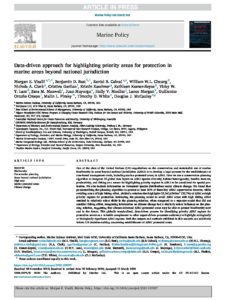Data-driven approach for highlighting priority areas for protection in marine areas beyond national jurisdiction

Author:
Morgan E. Visalli, Benjamin D. Best, Reniel B. Cabral, William W.L. Cheung, Nichola A. Clark, Cristina Garilao, Kristin Kaschner, Kathleen Kesner-Reyes, Vicky W. Y. Lam, Sara M. Maxwell, Juan Mayorga, Holly V. Moeller, Lance Morgan, Guillermo Ortuno Crespo, Malin L. Pinsky, Timothy D. White, Douglas J. McCauley
Publication Year:
2020
Citation:
Visalli, Morgan E., Benjamin D. Best, Reniel B. Cabral, William W.L. Cheung, Nichola A. Clark, Cristina Garilao, Kristin Kaschner, et al. “Data-Driven Approach for Highlighting Priority Areas for Protection in Marine Areas beyond National Jurisdiction.” Marine Policy, March 2020, 103927. https://doi.org/10.1016/j.marpol.2020.103927.
Description:
One of the aims of the United Nations (UN) negotiations on the conservation and sustainable use of marine biodiversity in areas beyond national jurisdiction (ABNJ) is to develop a legal process for the establishment of area-based management tools, including marine protected areas, in ABNJ. Here we use a conservation planning algorithm to integrate 55 global data layers on ABNJ species diversity, habitat heterogeneity, benthic features, productivity, and fishing as a means for highlighting priority regions in ABNJ to be considered for spatial protection. We also include information on forecasted species distributions under climate change. We found that parameterizing the planning algorithm to protect at least 30% of these key ABNJ conservation features, while avoiding areas of high fishing effort, yielded a solution that highlights 52,545,634 km2 (23.7%) of ABNJ as high priority regions for protection. Instructing the planning model to avoid ABNJ areas with high fishing effort resulted in relatively minor shifts in the planning solution, when compared to a separate model that did not consider fishing effort. Integrating information on climate change had a similarly minor influence on the planning solution, suggesting that climate-informed ABNJ protected areas may be able to protect biodiversity now and in the future. This globally standardized, data-driven process for identifying priority ABNJ regions for protection serves as a valuable complement to other expert-driven processes underway to highlight ecologically or biologically significant ABNJ regions. Both the outputs and methods exhibited in this analysis can additively inform UN decision-making concerning establishment of ABNJ protected areas.
See related content:
- Explore the site by related topics: Habitat and Biodiversity Loss
